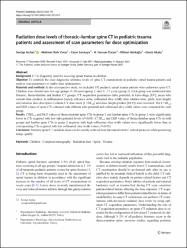| dc.contributor.author | Arslan, Sevtap | |
| dc.contributor.author | Onur, Mehmet Ruhi | |
| dc.contributor.author | Sarıkaya, Yasin | |
| dc.contributor.author | Özcan, H. Nursun | |
| dc.contributor.author | Haliloğlu, Mithat | |
| dc.contributor.author | Akata, Deniz | |
| dc.date.accessioned | 2022-04-29T12:22:53Z | |
| dc.date.available | 2022-04-29T12:22:53Z | |
| dc.date.issued | 14.10.2021 | en_US |
| dc.identifier.citation | Arslan, S., Onur, M. R., Sarıkaya, Y., Özcan, H. N., Haliloğlu, M., & Akata, D. (2022). Radiation dose levels of thoracic–lumbar spine CT in pediatric trauma patients and assessment of scan parameters for dose optimization. Pediatric Radiology, 52(1), 65-74. | en_US |
| dc.identifier.issn | 0301-0449 | |
| dc.identifier.issn | 1432-1998 | |
| dc.identifier.uri | https://doi.org/10.1007/s00247-021-05170-0 | |
| dc.identifier.uri | https://hdl.handle.net/20.500.12933/878 | |
| dc.description.abstract | Background
CT is frequently used for assessing spinal trauma in children.
Objective
To establish the local diagnostic reference levels of spine CT examinations in pediatric spinal trauma patients and analyze scan parameters to enable dose optimization.
Materials and methods
In this retrospective study, we included 192 pediatric spinal trauma patients who underwent spine CT. Children were divided into two age groups: 0–10 years (group 1) and 11–17 years (group 2). Each group was subdivided into thoracic, thoracolumbar and lumbar CT groups. CT acquisition parameters (tube potential, in kilovoltage [kV]; mean tube current–time product, in milliamperes [mAs]; reference mAs; collimated slice width; tube rotation time; pitch; scan length) and radiation dose descriptors (volume CT dose index [CTDIvol] and dose–length product [DLP]) were recorded. The CTDIvol and DLP values of spine CTs obtained with different tube potential and collimated slice width values were compared for each group.
Results
CTDIvol and DLP values of thoracolumbar spine CTs in group 1 and lumbar spine CTs in group 2 were significantly lower in CTs acquired with low tube potential levels (P<0.05). CTDIvol and DLP values of thoracolumbar spine CTs in both groups and lumbar spine CTs in group 2 acquired with high collimated slice width values were significantly lower than in corresponding CTs acquired with low collimated slice width values (P<0.05).
Conclusion
Pediatric spine CT radiation doses can be notably reduced from the manufacturers’ default protocols while preserving image quality. | en_US |
| dc.language.iso | eng | en_US |
| dc.publisher | Springer Verlag | en_US |
| dc.relation.isversionof | 10.1007/s00247-021-05170-0 | en_US |
| dc.rights | info:eu-repo/semantics/embargoedAccess | en_US |
| dc.subject | Children | en_US |
| dc.subject | Computed tomography | en_US |
| dc.subject | Radiation dose | en_US |
| dc.subject | Spine | en_US |
| dc.subject | Trauma | en_US |
| dc.title | Radiation dose levels of thoracic–lumbar spine CT in pediatric trauma patients and assessment of scan parameters for dose optimization | en_US |
| dc.type | article | en_US |
| dc.authorid | 0000-0003-4504-1335 | en_US |
| dc.department | AFSÜ, Tıp Fakültesi, Dahili Tıp Bilimleri Bölümü, Radyoloji Ana Bilim Dalı | en_US |
| dc.contributor.institutionauthor | Sarıkaya, Yasin | |
| dc.identifier.volume | 52 | en_US |
| dc.identifier.issue | 1 | en_US |
| dc.identifier.startpage | 65 | en_US |
| dc.identifier.endpage | 74 | en_US |
| dc.relation.journal | Pediatric Radiology | en_US |
| dc.relation.publicationcategory | Makale - Uluslararası Hakemli Dergi - Kurum Öğretim Elemanı | en_US |
















